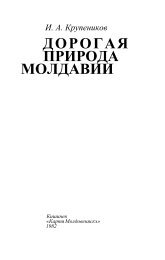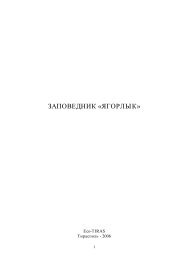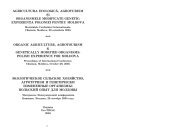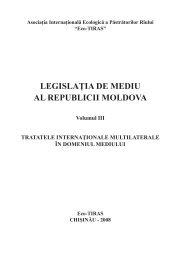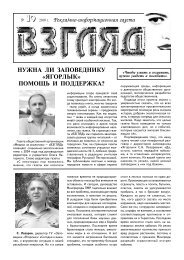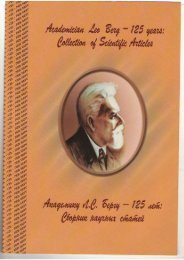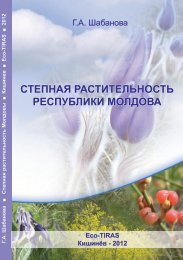Results and discussionDuring 2009 (spring-summer period) the decreasingtendency of the content of phosphorus forms, especiallyfor P7, P10 and P11, was recorded along river Dniester(Fig. 2). The maximal amounts of these forms wereregistered in lake Dubasari (Oxentia and Malovata sites).Nevertheless, for some forms (orthophosphates P6 andorganic-phosphorus P8) higher contents were registeredfor Vadul-lui-Voda site.Seasonally, the decreasing tendency of the amountsof most phosphorus forms (dissolved condensed P7 andorganic P8 forms, also particulate P10 and P11 forms)was registered from spring towards summer. On thewhole, seasonal dynamics of most phosphorus formsregistered during 2009 agree well with ones establishedduring 2004 [6].Percentage distribution of phosphorus forms inparticulate materials is presented in Fig. 3. Generally,the amounts of organic fraction (P12) registered during2009 agree well with ones established during 2004.Much more changes were registered for inorganicforms, orthophosphate P10 and condensed forms P11(polyphosphates and pyrophosphates).Concerning phosphorus forms in bottom sediments(Fig. 4), spatial dynamics was more evidence for totalphosphorus (form P<strong>13</strong>), being registered the decreasingtendency of the content along river Dniester. The maximalamounts were registered in lake Dubasari (Oxentia andMalovata sites). Seasonally, the increasing tendency ofthe amounts of total phosphorus (form P<strong>13</strong>) was registeredfrom spring towards summer. On the whole, spatial andseasonal dynamics of total phosphorus registered during2009 agree well with ones established during 2004 [6].Percentage distribution of organic and inorganicphosphorus in particulate materials and bottom sedimentswas similar during the summer of 2004 and 2009 years(Fig. 5).In large quantities phosphorus compounds havefertilizing effect for aquatic ecosystem affecting itseutrophication level. According to Directives of EuropeanCommunity [7-9], the eutrophication level is recommendedto be given on the basis of quality grade thresholds forFig. 2. Spatial and seasonal dynamics of phosphorus forms for river Dniester during 2009.Dissolved forms P6, P7, P8 –orthophosphate, condensed forms (poly– and pyrophosphates) and organic-phosphorus, respectively.Phosphorus forms in particulate forms P10, P11, P12 – orthophosphates, condensed forms and organic-phosphorus, respectively.Fig. 3. Percentage distribution of phosphorus forms in particulate materials (summer, 2004 and 2009 years).P10, P11, P12 – orthophosphates, condensed forms and organic-phosphorus in particulate materials, respectively.— 193 —
Fig. 4. Spatial and seasonal dynamics of phosphorus forms in bottom sediments along river Dniester (2009).P<strong>13</strong> – total phosphorus, P 14 – inorganic phosphorus, P 15 – organic phosphorus.Fig. 5. Percentage distribution of phosphorus forms in particulate materials (PM) and bottom sediments (BS) from river Dniester(Vadul-lui-Voda site). Phosphorus forms: Pinorg – inorganic phosphorus, Porg – organic phosphorus.nitrates, phosphorus, chlorophyl, oxygen etc. (otherparameters including bioindicators). Nevertheless, whichphosphorus forms should be considered for estimationof eutrophication level is questionable, e.g. according torecommendations [8] eutrophication level in rivers shouldbe estimated on the basis of total phosphorus content(form P1, Fig.1) while according to later recommendations[9] eutrophication level in rivers should be estimated on thebasis of soluble reactive phosphorus (form P5, Fig. 1).Obtained data for soluble reactive phosphorus (form P5)suggest that researched sector of river Dniester should beattributed to mesotrophic level of eutrophication (0,02-0,1 mgP/L), while on the basis of data for total phosphorus content(form P1) should be attributed to oligotrophic level of eutrophication(0,05-0,2 mg/L P). Unfortunately, quality grade ofphosphorus forms in bottom sediments there isn’t yet established,consequently at present is questionable to discussits influence onto eutrophication level of water bodies.ConclusionsThe scheme for determination of phosphorus forms inwater and particulate materials according to World HealthOrganization classification was evaluated. Additionally,this scheme was tested for estimation of phosphoruscontent in bottom sediments. The supplemented schemeallows the analysis of the phosphorus forms for theentirely system “water – particulate materials – bottomsediments”, and considerably extends possibilities forinterpretation of phosphorus dynamics in natural waters.References1. Directive 2006/11/EC of the European Parliament and theCouncil of the 15 th of February, 2006 on pollution caused by certaindangerous substances discharged into the aquatic environment of theCommunity.2. Madera V., Allen H.E., Minear R.A., (1982), Non-metallicConstituents, in: Examination of Water for Pollution Control, A ReferenceHandbook, M. J. Sues, World Health Organization, Regional Office forEurope, Copenhagen, Denmark (Eds.), 1st Edition, vol. 2, PergamonPress, Oxford-New York-Toronto-Sydney-Paris-Frankfurt.3. Rusu V., Postolachi L., Lupascu T. Phosphorus content inwater, particulate materials and sediments of river Prut. EnvironmentalEngineering and Management Journal. 2006, vol. 5, No. 4, p. 591-596.4. Postolachi L. Peculiarities of phosphorus dynamics in particulatematerials for lakes from Chisinau Researches in chemistry field, vol. II,Chisinau. -2003. -p. 196– 199 (Rom).5. Postolachi L., Rusu V., Lupascu T. Phosphorus forms inwater-particulate materials-bottom sediments system in river Dniester/Scientific Bulletin, series of Natural sciences, No. 2 (15), Chisinau,– 2005. p. 1<strong>13</strong>-116 (Rom)6. Postolachi L., Rusu V., Lupascu T. Phosphorus forms in water,particulate materials, bottom sediments in river Dniester / Proc. Int.Conference “Integrated management of natural resources in thetransboundary Dniester river basin. September 16-17, 2004, p. 242-244(Rom)7. Directive 91/676/EEC of the European Parliament and theCouncil of the 12 th of December, 1991 concerning the protectionof waters against pollution caused by nitrates from agriculturalsources.8. “Nitrates” Directive 91/676/EEC. Status and trends of aquaticenvironment and agricultural practice. Development guide for MemberStates’ reports, ISBN 92-828-9379-0, 2000.9. Review of 2007-2010 Action Programme for the Nitrates Directive.Northern Ireland. Recommendations from the Scientific Working Group21 December 2009 -89p.— 194 —
- Page 3 and 4:
Descrierea CIP a Camerei Nationale
- Page 5 and 6:
Уважаемые коллеги,
- Page 7 and 8:
щегосударственной
- Page 9 and 10:
доме, в котором мы в
- Page 11 and 12:
шие глубины на заде
- Page 13 and 14:
с малыми восстанов
- Page 15 and 16:
Литература1. Жадин
- Page 17 and 18:
Рис. 3. Многолетняя
- Page 19 and 20:
тера и глубины изме
- Page 21 and 22:
ПОДДЕРЖАНИЕ БИОРАЗ
- Page 23 and 24:
Таблица 5. Оптималь
- Page 25 and 26:
Таблица. Результат
- Page 27 and 28:
ФОРМИРОВАНИЕ БИОЦЕ
- Page 29 and 30:
Подавляющее больши
- Page 31 and 32:
Рис.1. Днестр вблизи
- Page 33 and 34:
сопоставимости дан
- Page 35 and 36:
ции с международны
- Page 37 and 38:
А.Н. Бургеля, К.П. Бу
- Page 39 and 40:
Выводы1. Уже на само
- Page 41 and 42:
тегории, виды и пор
- Page 43 and 44:
санитарно-эпидемио
- Page 45 and 46:
Таблица 4. Распреде
- Page 47 and 48:
реационных, монито
- Page 49 and 50:
Шабановой Г.А. и Кух
- Page 51 and 52:
могут быть убраны,
- Page 53 and 54:
Турунчук. Связь с с
- Page 55 and 56:
Праздник «День Рек
- Page 57 and 58:
500ЈPРис. Распределе
- Page 59 and 60:
Н. Гроссу * , Р. Шакир
- Page 61 and 62:
Рис.1. Помесячное ра
- Page 63 and 64:
Calitatea apei r. Nistru conform gr
- Page 65 and 66:
Карта геохимическо
- Page 67 and 68:
лесу был дуб, сегод
- Page 69 and 70:
При предварительно
- Page 71 and 72:
щих улучшить социа
- Page 73 and 74:
ней опасных загряз
- Page 75 and 76:
ФотоприложениеФот
- Page 77 and 78:
в Украине - одесска
- Page 79 and 80:
тия по гидрохимиче
- Page 81 and 82:
ветствующих санита
- Page 83 and 84:
ния полей, так и для
- Page 85 and 86:
В. Экономический ан
- Page 87 and 88:
Таким образом, плат
- Page 89 and 90:
Рис. 2. Динамика нор
- Page 91 and 92:
Табл. 1а. Статистиче
- Page 93 and 94:
Выводы1. Наибольшее
- Page 95 and 96:
Для днестровской в
- Page 97 and 98:
ЭКОЭТИЧЕСКОЕ ВОСПИ
- Page 99 and 100:
Таблица 1. Валовое с
- Page 101 and 102:
почвенный покров п
- Page 103 and 104:
always been the public concern of b
- Page 105 and 106:
и уникальными по си
- Page 107 and 108:
ются основными фак
- Page 109 and 110:
Рис. 4. Пораженность
- Page 111 and 112:
ight to use”. Varone et al. (2002
- Page 113 and 114:
mass media, etc., which belong to d
- Page 115 and 116:
В связи с тем, что К
- Page 117 and 118:
период поездки вых
- Page 119 and 120:
doutchinae (d’Orb.), выше з
- Page 121 and 122:
вместе с осадками в
- Page 123 and 124:
Таблица 4. Содержан
- Page 125 and 126:
efectuat în baza următorilor indi
- Page 127 and 128:
видуальных различи
- Page 129 and 130:
- соответствующее з
- Page 131 and 132:
ФАУНА КЛЕЩЕЙ ДРЕВЕ
- Page 133 and 134:
Таблица 1. Данные ра
- Page 135 and 136:
РЕКРЕАЦИОННЫЕ РЕСУ
- Page 137 and 138:
ЭТАПЫ ЭВОЛЮЦИИ БИО
- Page 139 and 140:
Плотина Дубоссарск
- Page 141 and 142:
чимые. При этом «пе
- Page 143 and 144: Схематически получ
- Page 145 and 146: Таблица 5. Данные на
- Page 147 and 148: Risks for biodiversity with tested
- Page 149 and 150: 14. Ярошенко M.Ф., Дед
- Page 151 and 152: 20082009Fig. 2. Structure of shrew
- Page 153 and 154: с природой (различн
- Page 155 and 156: делить в их предела
- Page 157 and 158: Таблица. Оценка эне
- Page 159 and 160: лах Приднестровья
- Page 161 and 162: ВыводыКраеведческ
- Page 163 and 164: вий среды жизнедея
- Page 165 and 166: Senecio besserianus Minder. Cypripe
- Page 167 and 168: Рис.1. Почвенная кар
- Page 169 and 170: половины площади п
- Page 171 and 172: Рис. 2. Современное
- Page 173 and 174: ПРИЧИНЫ ГЕОМОРФОЛО
- Page 175 and 176: RÂURILE MICI CU ŞANSE MARIDE A FI
- Page 177 and 178: ЭКОНОМИКО-ЭКОЛОГИЧ
- Page 179 and 180: прибрежной зоной (п
- Page 181 and 182: Строительство в пр
- Page 183 and 184: государственного у
- Page 185 and 186: ческий, социальный
- Page 187 and 188: ми, послужило весом
- Page 189 and 190: губительно влияющи
- Page 191 and 192: ных за контролем и
- Page 193: PECULARITIES OF DYNAMICS OF PHOSPHO
- Page 197 and 198: • inventory of point discharges s
- Page 199 and 200: СТЕРИЛИЗАЦИЯ КАК С
- Page 201 and 202: гормоны (в незначит
- Page 203 and 204: ПРОТОКОЛ ПО ПРОБЛЕ
- Page 205 and 206: воды ежегодно умир
- Page 207 and 208: РАЗРАБОТКА ПЛАНОВ
- Page 209 and 210: ставляет материаль
- Page 211 and 212: • Совершенствован
- Page 213 and 214: «Алые паруса». Таки
- Page 215 and 216: which the Committee is then require
- Page 217 and 218: нием, культурой и х
- Page 219 and 220: - Николаевская церк
- Page 221 and 222: Сброшенный на 50 м б
- Page 223 and 224: СТРУКТУРА ГЕОИНФОР
- Page 225 and 226: 4. Пространственная
- Page 227 and 228: На фазе пика числен
- Page 229 and 230: А.А. Тищенков, В.В. М
- Page 231 and 232: Распределение видо
- Page 233 and 234: цветковый (ККП, ЧКУ,
- Page 235 and 236: очередной задачей
- Page 237 and 238: схемой планировани
- Page 239 and 240: эксплуатационным п
- Page 241 and 242: ных дамб, с возвращ
- Page 243 and 244: ледствия от урбани
- Page 245 and 246:
ОСНОВНЫЕ ФОРМЫ ДЕГ
- Page 247 and 248:
УЧАСТИЕ НЕПРАВИТЕЛ
- Page 249 and 250:
струкции как от сбр
- Page 251 and 252:
Рогоз широколистны
- Page 253 and 254:
Таблица 3. Изменени
- Page 255 and 256:
В рамках первых тре
- Page 257 and 258:
Основные экскурсио
- Page 259 and 260:
2. Кравченко Е.Н. При
- Page 261 and 262:
Decision-Maker user group are respo
- Page 263 and 264:
может ее запускать,
- Page 265 and 266:
поражения населени
- Page 267 and 268:
тию РДЮЦ «ГУТТА - кл
- Page 269 and 270:
мость разработки н
- Page 271 and 272:
Биология. Подорожн
- Page 273 and 274:
банизированных тер
- Page 275 and 276:
Результаты исследо
- Page 277 and 278:
площадь ассимиляци
- Page 279 and 280:
Рис. 3. Дендрограмма
- Page 281 and 282:
Рис.1. Сезонная дина
- Page 283 and 284:
Молдовы и Приднест
- Page 285 and 286:
Ребята приехали в 10
- Page 287 and 288:
Рис. 1. Численность
- Page 289 and 290:
жений, в том числе э
- Page 291 and 292:
[4]. Несомненно, выжи
- Page 293 and 294:
КОНСТИТУЦИОНАЛЬНА
- Page 295 and 296:
В настоящее время б
- Page 297 and 298:
8. Суворцева В.Ю., Ру
- Page 299 and 300:
Окончание табл. 2Ок
- Page 301 and 302:
содержаниеПРЕДИСЛ
- Page 303 and 304:
А.П. Погребняк, В.Ф.
- Page 305:
Научное изданиеБАС


![[download]13,2 Mb - Eco - Tiras](https://img.yumpu.com/50284532/194/500x640/download132-mb-eco-tiras.jpg)
